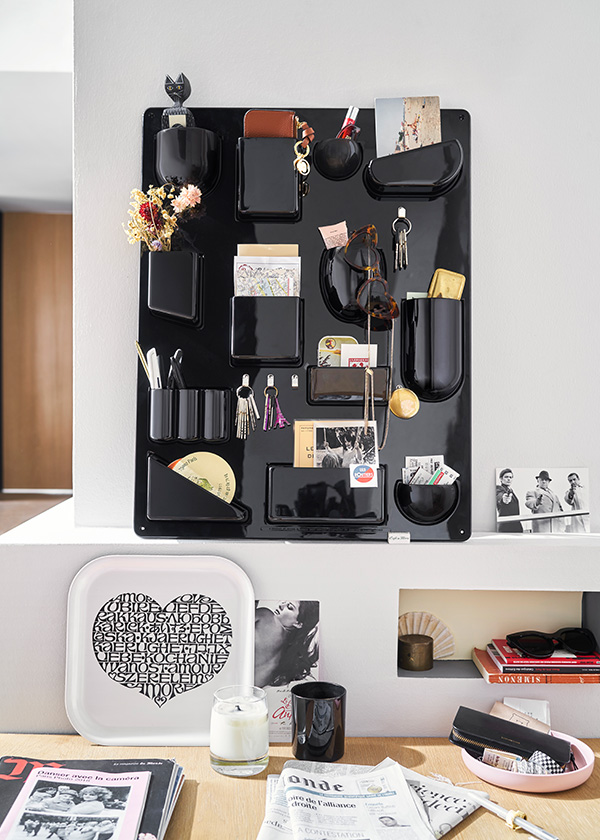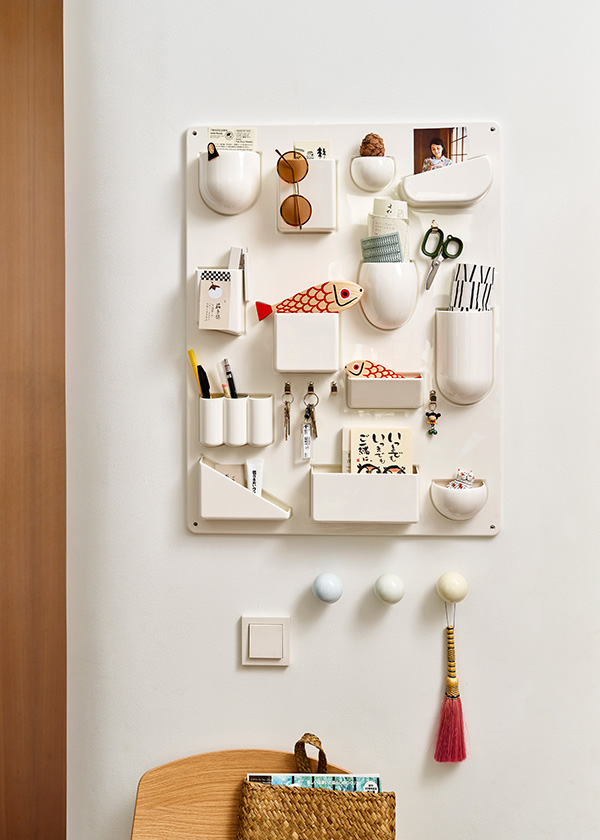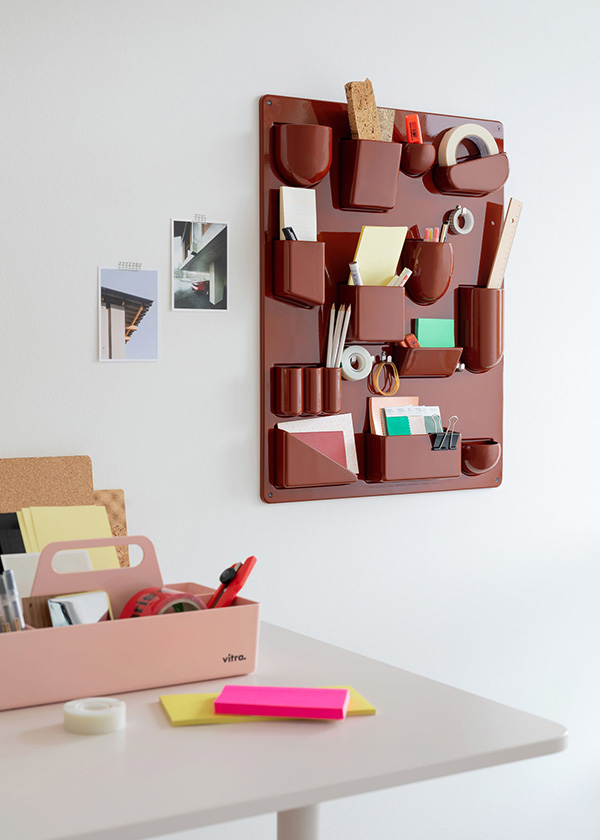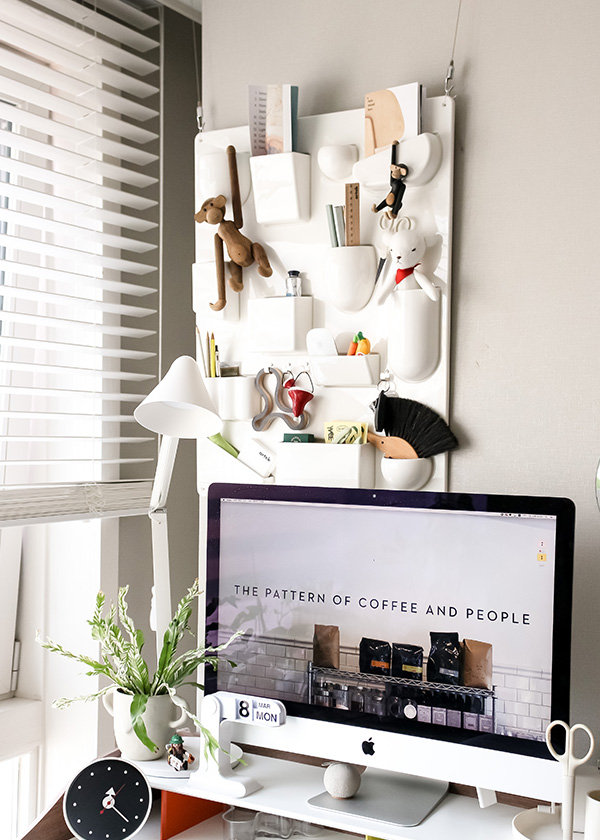Design icon: Vitra Uten Silo
Make the most of your wall space with the classic plastic, wall storage unit. This iconic design is versatile and practical, perfect for all homes.
It introduces a new way of organisation, with containers, clips, and metal hooks, to use for any purpose.
Designed by Dorothee Becker, this system was first produced and launched on the market in 1969 and a smaller version was issued in 1970 (Uten Silo II) in the colours black, white and red. After the success of the Uten Silo, Becker continued creating well-designed and practical everyday objects until 1989.
The woman who made tidying tasteful
Born in Germany in 1938, Dorothee Becker studied languages in Europe after being discouraged from studying design by her family. Becker was self-taught and moved to California with her husband, graphic and industrial designer Ingo Maurer, who’s famously known as the ‘poet of light’.
After moving to California, Becker took inspiration from the advice of Italian physician and educator Dr Maria Montessori, which then led her to create the first Uten.Silo.
Dr Maria Montessori came up with the Montessori education establishments, which emphasises individual progression and gives children opportunities to choose from a range of activities - they themselves guide how long and how many they want to do.
Originally Becker designed the Uten.Silo as a wooden toy for her children, consisting of different shapes on a board, but her children didn’t enjoy it. After realising her design wasn’t taken by children, she adapted the wooden toy into a plastic board with smooth containers and pockets that reminisced the drawers in her father’s drugstore.
Becker is the woman who made organising and tidying trendy, with a touch of playfulness. When researching her there wasn’t much written about her, and that unfortunately seems to be the case for most female designers from the 20th Century.
Even though the Uten.Silo is so iconic in the design industry and made such a big impact, there is still so little information about its designer. This is at odds to other designs such as the Eames Lounge Chair - everyone in the industry knows it’s designed by Charles and Ray Eames.
A versatile design
The Uten Silo is a versatile product that can be used and shaped to suit any lifestyle, whether that be for office supplies, DIY tools and even kitchen utensils.
Over the years the Uten Silo has been an overwhelming success, especially in Europe and the US market, where they were sold under the name “Wall-All”.
Why it should be celebrated
The 1960s were the decade of plastic, with brightly coloured new designs surfacing and hitting the markets. Designer Verner Panton created the infamous S-shaped chair and Italian brands Kartell and Artemide commissioned plastic products that would not have been made without the material.
However, production of the Uten.Silo was ceased when the oil crisis of 1974 hit the cost of plastic. The playful wall storage product was discontinued until 2002 when the Vitra Design Museum reissued both the original 1969 version and the smaller one from 1970.
Vitra has now modified its production of the wall storage unit to use post-industrial recycled ABS plastic which is also 100% recyclable. The Uten Silo RE also comes in new colours, including Japanese Red and Horizon Blue.
We hope you enjoyed this brief look into the history behind Dorothee Becker’s iconic Uten.Silo. If you’ve got your very own Uten.Silo, we would love to see how you style yours on Instagram by tagging us @nest_co_uk.
Design icon: Vitra Uten Silo
Make the most of your wall space with the classic plastic, wall storage unit. This iconic design is versatile and practical, perfect for all homes.
It introduces a new way of organisation, with containers, clips, and metal hooks, to use for any purpose.
Designed by Dorothee Becker, this system was first produced and launched on the market in 1969 and a smaller version was issued in 1970 (Uten Silo II) in the colours black, white and red. After the success of the Uten Silo, Becker continued creating well-designed and practical everyday objects until 1989.
The woman who made tidying tasteful
Born in Germany in 1938, Dorothee Becker studied languages in Europe after being discouraged from studying design by her family. Becker was self-taught and moved to California with her husband, graphic and industrial designer Ingo Maurer, who’s famously known as the ‘poet of light’.
After moving to California, Becker took inspiration from the advice of Italian physician and educator Dr Maria Montessori, which then led her to create the first Uten.Silo.
Dr Maria Montessori came up with the Montessori education establishments, which emphasises individual progression and gives children opportunities to choose from a range of activities - they themselves guide how long and how many they want to do.
Originally Becker designed the Uten.Silo as a wooden toy for her children, consisting of different shapes on a board, but her children didn’t enjoy it. After realising her design wasn’t taken by children, she adapted the wooden toy into a plastic board with smooth containers and pockets that reminisced the drawers in her father’s drugstore.
Becker is the woman who made organising and tidying trendy, with a touch of playfulness. When researching her there wasn’t much written about her, and that unfortunately seems to be the case for most female designers from the 20th Century.
Even though the Uten.Silo is so iconic in the design industry and made such a big impact, there is still so little information about its designer. This is at odds to other designs such as the Eames Lounge Chair - everyone in the industry knows it’s designed by Charles and Ray Eames.
A versatile design
The Uten Silo is a versatile product that can be used and shaped to suit any lifestyle, whether that be for office supplies, DIY tools and even kitchen utensils.
Over the years the Uten Silo has been an overwhelming success, especially in Europe and the US market, where they were sold under the name “Wall-All”.
Why it should be celebrated
The 1960s were the decade of plastic, with brightly coloured new designs surfacing and hitting the markets. Designer Verner Panton created the infamous S-shaped chair and Italian brands Kartell and Artemide commissioned plastic products that would not have been made without the material.
However, production of the Uten.Silo was ceased when the oil crisis of 1974 hit the cost of plastic. The playful wall storage product was discontinued until 2002 when the Vitra Design Museum reissued both the original 1969 version and the smaller one from 1970.
Vitra has now modified its production of the wall storage unit to use post-industrial recycled ABS plastic which is also 100% recyclable. The Uten Silo RE also comes in new colours, including Japanese Red and Horizon Blue.
We hope you enjoyed this brief look into the history behind Dorothee Becker’s iconic Uten.Silo. If you’ve got your very own Uten.Silo, we would love to see how you style yours on Instagram by tagging us @nest_co_uk.











